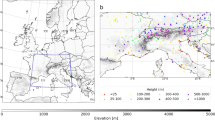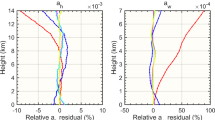Abstract
The original MicRAWinD (Microwave Radiometric Algorithm for Wind Direction retrieval) algorithm planned for use in reconstructing the near-surface wind direction in the Convergence space experiment (SE) is presented. The possibility of determining the wind direction based on radiometric measurements in two swaths of the radiometer stems from the anisotropy of surface radiation, which is manifested most clearly in the third Stokes parameter. Combining the results of measurements at different frequencies with their reliability factored in, one can improve the accuracy of reconstructing the wind direction. A new algorithm for enhancing the reliability of measurements which takes the real errors in measuring brightness temperatures into account is proposed. The algorithm has been tested with real data provided by the WindSat radiometric system. The results are compared with the Remote Sensing Systems (RSS) reconstruction data. A surface region with different geophysical parameters (sea surface temperature, vapor content, wind speed and direction, and cloud water content) is chosen for this comparison. The reconstruction algorithm involves solving the direct problem of calculating the radio brightness temperatures at linear ±45° polarizations with subsequent calculations of the third Stokes parameter for 37, 18.7, and 10.7 GHz. The initial meteorological parameters for the direct problem are products provided by RSS. The sensitivity of radiometric instruments is taken into account in the simulation process. The solution of the inverse problem and the comparison results demonstrate that this algorithm retrieves the wind direction with fine qualitative agreement both from the results of radiometric observations at a single frequency and from multifrequency data.









Similar content being viewed by others
REFERENCES
Bespalova, E.A., Veselov, K.M., Glotov, A.A., Militskii, Yu.A., Mirovskii, V.G., Pokrovskaya, I.V., Popov, A.E., Raev, M.D., Sharkov, E.A., and Etkin, V.S., Study of wind wave anisotropy by variations of polarized thermal radiation, Dokl. Akad. Nauk SSSR, 1979, vol. 246, no. 6, pp. 1482–1485.
Bespalova, E.A., Veselov, V.M., Gershenzon, V.E., Militskii, Yu.A., Mirovskii, V.G., Pokrovskaya, I.V., Raev, M.D., Semin, A.G., Smimov, N.K., Skachkov, V.A., Trokhimovsky, Yu.G., Khapin, Yu.B., Chistyakov, V.N., Sharkov, E.A., and Etkin, V.S., Determination of surface wind velocity from measured polarized anisotropy of intrinsic and scattered microwave radiation, Issled. Zemli Kosmosa, 1982, no. 1, pp. 87–94.
Freilich, M.H. and Dunbar, R.S., The accuracy of the NSCAT 1 vector winds: Comparisons with national data buoy center buoys, J. Geophys. Res., 1999, vol. 104, pp. 11231–11246.
Gaiser, P.W., St. Germain, K.M., Twarog, E.M., Poe, G.A., Purdy, W., Richardson, D., Grossman, W., Jones, W.L., Spencer, D., Golba, G., Cleveland, J., Choy, L., Bevilacqua, R.M., and Chang, P.S., The WindSat spaceborne polarimetric microwave radiometer: Sensor description and early orbit performance, IEEE Trans. Geosci. Remote Sens., 2004, vol. 42, no. 11, pp. 2347–2361.
Meissner, T. and Wentz, F.J., The complex dielectric constant of pure and sea water from microwave satellite observations, IEEE Trans. Geosci. Remote Sens., 2004, vol. 42, no. 9, pp. 1836–1849.
Meissner, T. and Wentz, F.J., The emissivity of the ocean surface between 6 and 90 GHz over a large range of wind speeds and earth incidence angles, IEEE Trans. Geosci. Remote Sens., 2012, vol. 50, no. 8, pp. 3004–3026.
Monaldo, F., Expected differences between buoy and radar altimeter estimates of wind speed and significant wave height and their implications on buoy-altimeter comparisons, J. Geophys. Res., 1988, vol. 93, pp. 2285–2303.
Narvekar, P.S., Heygster, G. and Tonboe, R., Analysis of WindSat data over Arctic sea ice, Final version, Technical report for the EUMETSAT satellite application facility on ocean and sea ice, Vis. Sci. Activity SG08-VSQ1: Investigations into use of passive polarimetric microwave radiometry for sea ice retrieval, Rev. 1, Bremen, 2008.
Sadovskii, I.N. and Sazonov, D.S., Determination of the modulus of surface wind velocity from data of the MIRS multifrequency radiometer-spectrometer, Pyatnadtsataya vserossiiskaya otkrytaya ezhegodnaya konferentsiya “Sovremennye problemy distantsionnogo zondirovaniya Zemli iz kosmosa”. Tezisy dokladov (Book of Abstracts of the Fifteenth All-Russian Open Annual Conference “Current Problems of the Earth’s Remote Sensing from Space”), Moscow: IKI RAN, 2017, p. 501.
Sazonov, D.S., Azimuthal variability of the radio emission wavy water surface on the basis of microwave measurements, Pyatnadtsataya vserossiiskaya otkrytaya ezhegodnaya konferentsiya “Sovremennye problemy distantsionnogo zondirovaniya Zemli iz kosmosa”. Tezisy dokladov (Book of Abstracts of the Fifteenth All-Russian Open Annual Conference “Current Problems of the Earth’s Remote Sensing from Space”), Moscow: IKI RAN, 2017, p. 301.
Sazonov, D.S., Kuzmin, A.K., and Sadovskii, I.N., Study of azimuthal anisotropy of intrinsic radio thermal radiation of wavy water surface in CAPMOS experiments, Preprint of Space Research Inst., Russ. Acad. Sci., Moscow, 2013, no. Pr-2170, p. 23.
Sharkov, E.A., Scientific tasks of the Konvergentsiya space experiments in the Russian Segment of the International Space Station, Pyatnadtsataya vserossiiskaya otkrytaya ezhegodnaya konferentsiya “Sovremennye problemy distantsionnogo zondirovaniya Zemli iz kosmosa”. Tezisy dokladov (Book of Abstracts of the Fifteenth All-Russian Open Annual Conference “Current Problems of the Earth’s Remote Sensing from Space”), Moscow: IKI RAN, 2017, p. 468.
Sterlyadkin, V.V., Sazonov, D.S., Pashinov, E.V., and Kuzmin, A.V., Description of the algorithm for determining the surface wind direction by radiometric measurements from space, Pyatnadtsataya vserossiiskaya otkrytaya ezhegodnaya konferentsiya “Sovremennye problemy distantsionnogo zondirovaniya Zemli iz kosmosa”. Tezisy dokladov (Book of Abstracts of the Fifteenth All-Russian Open Annual Conference “Current Problems of the Earth’s Remote Sensing from Space”), Moscow: IKI RAN, 2017, p. 468.
Wentz, F.J. and Meissner, T., AMSR Ocean Algorithm, Version 2, Tech. Rep. 121599A-1, Santa Rosa, Calif.: Remote Sensing Systems, 2002. http://www.remss.com/ papers/amsr/AMSR_Ocean_Algorithm_Version_2.pdf.
Funding
This study was supported by the Russian Foundation for Basic Research, grant no. 18-02-01009.
Author information
Authors and Affiliations
Corresponding author
Additional information
Translated by D. Safin
Rights and permissions
About this article
Cite this article
Sazonov, D.S., Sterlyadkin, V.V. & Kuzmin, A.V. Testing the Algorithm for Determining the Near-Water Wind Direction Field Using Satellite Radiopolarimetric Measurements. Izv. Atmos. Ocean. Phys. 55, 949–955 (2019). https://doi.org/10.1134/S0001433819090457
Received:
Published:
Issue Date:
DOI: https://doi.org/10.1134/S0001433819090457




